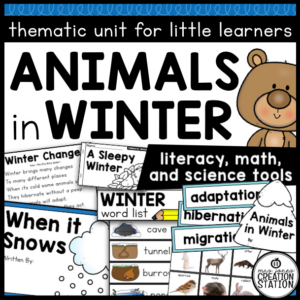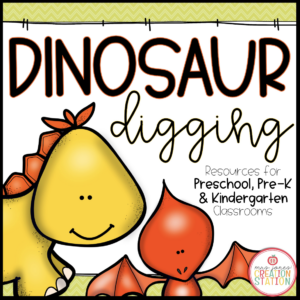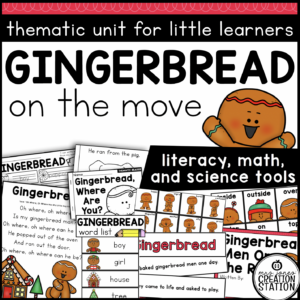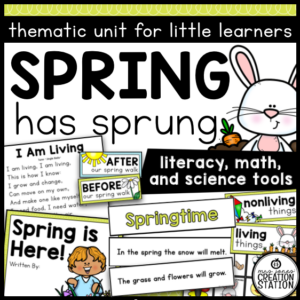Menu
In this pack, whole group, small groups and independent resources are used for introducing, teaching, and reviewing facts about bugs. Lesson plans with mini-lessons, center activities, and an interactive page are available for each week of instruction.
Buy the BUNDLE and SAVE! You can purchase this resources in the Thematic Activities for Little Learners Bundle and the Little Learners Mega-Bundle!
THIS RESOURCE INCLUDES
Week 30 Plans
In this unit, lesson plans during an insect unit are provided. Pick and choose what ideas and resources work for your learners.
Insects – Whole Group
First of all, these resources are used during whole group instruction for a bug theme. They include a poem, word cards, tracing page and table sign in sheets.
Bug Interactive Poem
Next, use this poem during a thematic lesson, whole group or a literacy center and have learners learn different types of bugs
Insects Thematic Plans
First of all, use these plans as a guide for engaging insect read alouds and activities in the classroom.
Insect or Not
In this lesson, read Bugs Are Insects and use the poster and sorting activity to determine what makes an insect. Learners may complete this section of their insect book.
Insect Adaptations
Next, read I Love Bugs and use the poster and chart to discuss different insect adaptations. Learners may complete this section of their insect book.
Insect Habitats
In this lesson, read Bug Homes and use the poster and chart to discuss different insect habitats. Learners may complete this section of their insect book.
Insect Life Cycle
Next, read Caterpillar to Butterfly and use the poster and chart to discuss different insect life cycles. Learners may complete this section of their insect book.
Invent an Insect
In this lesson, read Beetle Bop and review information from the unit. Have learners use what they have learned to create their own insect.
Bug Sensory Charts
In this activity, learners will explore catching bugs with the five senses. Complete the charts together and have learners draw and write about their experience catching bugs using their senses on the interactive page.
Bugs Predictable Chart Class Book
With this resource, create a class book from the predictable chart created during the week.
Literacy Center | Missing Vowel
First, have learners place the correct vowel sounds on each of the word cards.
Literacy Center | Short Vowel Sort
Next, have learners sort the pictures on a pocket chart by their vowel sound.
Literacy Center | WTR Sight Words
After that, have learners write the words they find around the room.
Math Center | Addition
First, have learners roll a number and use the mat to solve their equation.
Math Center | Shape Sort
Next, have learners sort the pictures by their shape.
Math Center | Subtraction
After that, have learners choose an equation and use the subtraction mat to solve.
WEBSITE | FACEBOOK | INSTAGRAM | PINTEREST | TEACHERS PAY TEACHERS
© Mrs. Jones’ Creation Station, Inc
How can I see what is new in the MJCS store?
Be the first to know about new discounts, freebies, and new products. You can also subscribe to our newsletter to receive access to resources only available to MJCS subscribers, as well as, special offers and ideas!
How can I get credit for my TpT purchases?
Go to your account button at the top of the page. Under the “Buy” section, click “My Purchases “. Beside each purchase you’ll see a Provide Feedback button. Simply click the button and you will be taken to a page where you can give a quick rating and leave a comment for the product. Each time you give feedback, TpT gives you feedback credits that you use to lower the cost of your future purchases. Please leave detailed feedback for each resource, so we are able to create better resources for teachers and students.
How can I find a certain activity in a large PDF file?
If the resource you purchase has a variety of activities compiled into one PDF find the table of contents and click on the activity title. This should take you to that specific activity in the resource.
What can I do if I have a question about a resource?
If you have any questions regarded a resource before purchasing please email me at mrsjonescreationstation[at]gmail.com. Once you have purchased the resource you may use the “Product Q and A” tab on the product page to ask a question, as well.
How do I know if a resource has been updated?
Go to your account button at the top of the page. Under the “Buy” section, click “My Purchases “. Choose to “sort by: recently updated” to see what resources have been updated since you downloaded them last. You can download any updates from there. If a file has been updated, you will see a notification under the resource that says “Newly Updated – Download for Free!”
This item is a paid product created by Mrs. Jones’ Creation Station, Inc. Copying any part of this product, redistributing, selling or placing it on the internet in any form is strictly forbidden and is a violation of the Digital Millennium Copyright Act (DMCA). Thank you for respecting our work!
YES, YOU CAN…
NO, YOU CAN’T…
Click here for a detailed post with step-by-step directions.
You will need to download fonts specified in the resource and install it on your computer before downloading the editable file.
Install the most recent version of Adobe Reader onto your computer. If you have any problems editing, viewing or printing a file make sure your Adobe Reader is updated.
Now you can download the file to your computer. Once the file has downloaded open in Adobe Reader. You should be able to view the editable fields and the text should match the product description. If you have any problems editing the file, make sure you have followed the directions above and then contact me at mrsjonescreationstation[at]gmail.com




